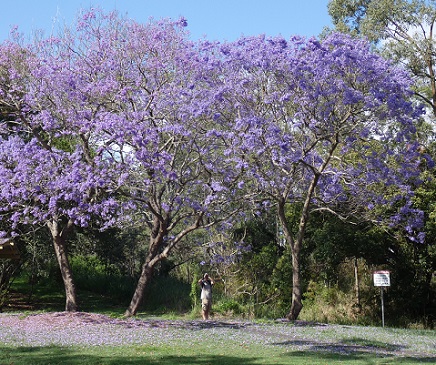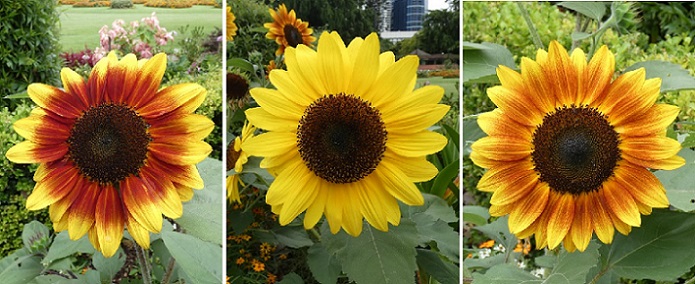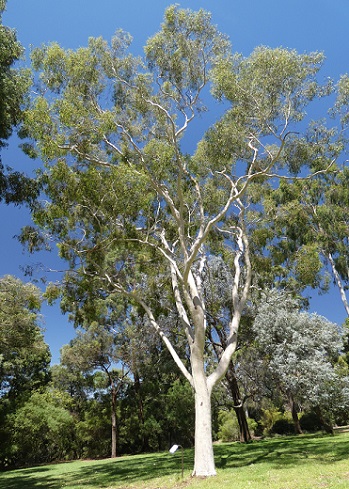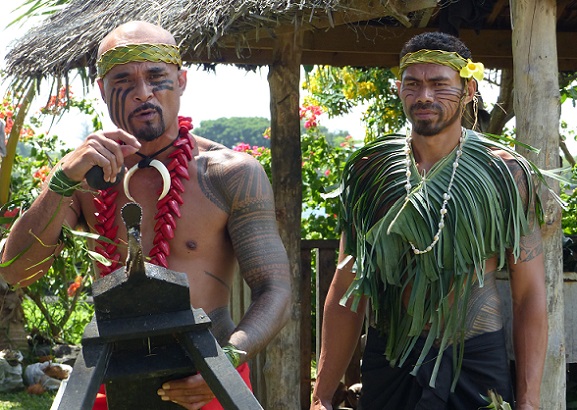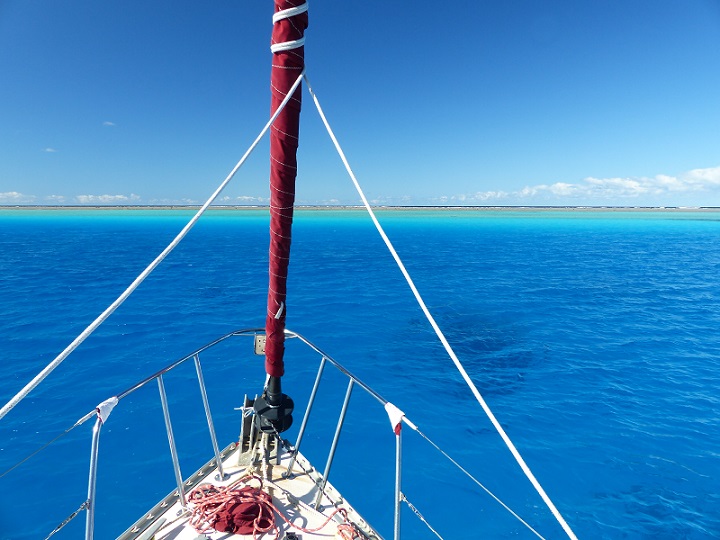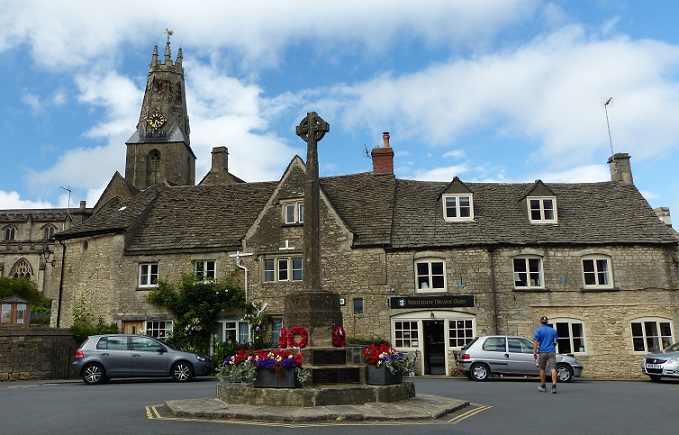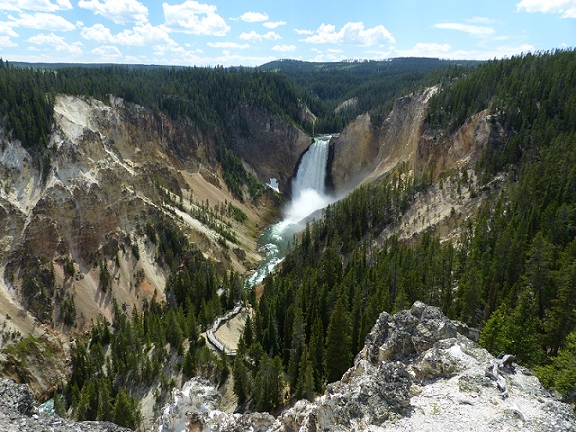
Tregoning
12 April 2024 | We are back aboard Tregoning in Mersin Marina, Mersin, Türkiye
02 April 2024 | We are in Toronto Airport, Canada: Tregoning is in Mersin Marina, Mersin, Türkiye
25 February 2024 | We are back in Gainesville, FL: Tregoning is in Mersin Marina, Mersin, Türkiye
18 February 2024 | We are in Glenwood, New Mexico: Tregoning is in Mersin Marina, Mersin, Türkiye
12 February 2024 | We are in Morro Bay, California: Tregoning is in Mersin Marina, Mersin, Türkiye
19 January 2024 | We are in Vancouver, BC Canada: Tregoning is in Mersin Marina, Mersin, Türkiye
01 January 2024 | We are in Washington State: Tregoning is in Mersin Marina, Mersin, Türkiye
15 December 2023 | We are in Minnesota: Tregoning is in Mersin Marina, Mersin, Türkiye
18 November 2023 | We are in Florida: Tregoning is in Mersin Marina, Mersin, Türkiye
29 October 2023 | We're in Florida - Tregoning is at B-dock, Mersin Marina, Mersin, Türkiye
21 October 2023 | 7 Oda Kapadokya Cave Hotel, Ürgüp, Türkiye
14 October 2023 | Hotel Aşikoğlu, Boğazkale, Türkiye
07 October 2023 | B-dock, Mersin Marina, Mersin, Türkiye
19 September 2023 | “Chez Jon & Angela”, Near Otterton, Devon, UK
14 September 2023 | Airbnb in Fortuneswell on the Isle of Portland, Dorset, UK
11 September 2023 | With Mike, Grange-over-Sands, Cumbria, UK
03 September 2023 | Ardington House, Ardington, Oxfordshire, UK
24 August 2023 | Near "Chez Joan and Peter", College of Roseisle, Moray, Scotland
11 August 2023 | Andrew's house (not exactly), Lichfield, UK
22 July 2023 | Chez Gail, near the New York Café, Budapest, Hungary
The curse of second halves?
14 February 2023 | Anchored off Uligamu, northern Maldives
Alison Stocker | Photo: Waterfront near the harbor on Uligamu Island
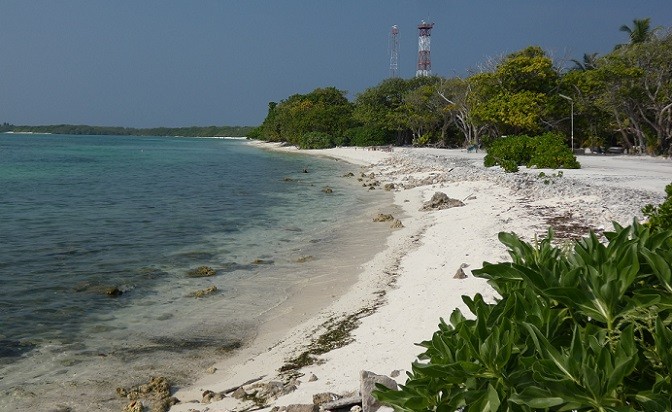
Our last two passages have both involved a good half and a bad half. The first, on our way to Sri Lanka, with equipment problems, the second with my illness. With the passage from the Maldives to Djibouti being expected to take between 18 and 22 days (depending upon the wind and currents), an unpleasant second half would be really long and tedious. So, we must be optimistic that this is not going to be a permanent trend.
We had left Sri Lanka at exactly the time we predicted, 8 am on Sunday (5th February). Our agent Uresh had come to the boat at 7:30 am and we followed him to the Immigration Office to get the exit stamps in our passports. He then kindly waited to help with our docklines, although several neighboring sailors, including Klara, were keen to assist. There was no wind, so it was easy to have the lines released from the dock, our bow was given a good shove, and we could simply clear the boat in front of us and maneuver out of the small yacht basin. The process was made easier by Randall and me having removed all the rubber snubbers from the docklines and reversed them, so that they could be untied from the dock rather than the boat.
Our four fenders had made a valiant effort in the trying circumstances of the surge and assorted rubber buffers on the concrete wall. Our only ball-float had started to deflate in the final couple of days, but we think that Randall may be able to patch it with dinghy repair equipment. Three of the fender covers were completely destroyed, and one I was able to salvage, although it now looks as though it had been a test dummy for make-up artists for a Frankenstein movie...the artists who were rejected... The covers are not intended to protect the fenders but to prevent them from grinding dirt into the hull's paint. I have one unused cover left but I suppose that I will have to get more fabric and start again for the rest...sigh.
Leaving Galle, we motored for about eight hours into the Laccadive Sea (which divides Sri Lanka and India), until the wind filled in. The angle was good, so we just unfurled the jib and for the next 38 hours, that was all that we needed. The waves seemed unnecessarily sloppy and choppy during the night and Monday morning, but after that they gradually eased, and conditions became very pleasant. With the wind decreasing and coming more from off the bow rather than the stern, we raised the mainsail around dawn on Tuesday, and it looked as though it was going to be a very uneventful, enjoyable passage.
Those of delicate constitution are encouraged to skip the next two paragraphs.
Within a couple of hours, however, the bottom fell out of my world...or the other way around, and the happy half of the passage was over. After some hurried trips to the head (boat's toilet), I found myself on watch at 8 am, starting to shiver, despite warm weather, sweatpants, and my raincoat. Quickly administering the medical thermometer, Randall confirmed that I was getting a fever at 100.4°F (38 °C), so off I was sent to bed. Uh oh... next I was purging in both directions despite not having much left in my system. Having being fortunate enough to have a stomach that I have often rather brashly described as like a concrete mixer, and being so lucky never to have been actually seasick, I was a bit of a novice at heaving over the side. By that stage it was more of a reflex gesture than actually accomplishing anything.
Four hours of sleep later, Randall was horrified to find that my temperature had increased to 103.5°F (39.7°C). It was time to implement some of the suggestions in the various "Medicine Aboard" types of books that he had been reading while I slept. I was able to keep small amounts of electrolyte solution/Gatorade down by this time, so he started me on a three-day course of Cipro antibiotic. Even though they were simply swallowed, they are some of the bitterest things I have ever tasted...yuk! Thankful that the vomiting was over, I was not quite as confident about the other problem, so I constructed a homemade diaper from an old handtowel sandwiched between two pairs of knickers. It probably looked as pathetic as it sounds.
Thankfully, by 4 pm my temperature was starting to recede, but Randall nobly planned how he would accomplish all of the night watches on his own, allowing me to sleep. He made himself a bed in the cockpit and set his alarm to wake him every 15 or 20 minutes to look around. It was obviously not a very restful night for him, and he has a greater sympathy for single handers now, but it made all the difference to me. By 8 am, my temperature was close to normal, and I was feeling well enough to sit up in the cockpit and read while on watch, letting Randall get several hours of much-needed sleep.
Just before midnight, Randall had furled the jib and started the engine because the wind was too light. We motor-sailed with the mainsail and very low rpms on the engine the rest of the way, about another 34 hours. We could have arrived at Uligamu several hours earlier than 10 am on Thursday, but we wanted to be sure to have good light as we entered the atoll and looked for somewhere to anchor. I was not sorry to have as much time as possible to continue to recover my strength.
Which particular type of gastric infection had I suffered, we could not tell but the Cipro and a good dose of Pepto-Bismol seemed to settle things down. Of course, I started to suspect every food that I had eaten in the preceding 72 hours. Several, probably innocent, items took a trip to the depths to be sure...not much seemed appetizing for a while so this was no great hardship for me. In all of our traveling, Randall and I have been remarkably lucky in hardly ever having Delhi Belly or some version thereof. We do not drink water ashore, and wash fruit etc., before eating it. I probably have an injudiciously cavalier attitude towards salads, but the only things that we had eaten ashore within 24 hours before we left were some bakery items that we shared. Two places that we ate onshore slightly surprised us by bringing the requested cutlery dipped in a bowl of water (of unknown origin), but those meals had been long before our departure. So, we shall never know the source of this ailment, a puzzle particularly confused by the fact that Randall and I had eaten and drunk the same things for the last few days and he, mercifully, never succumbed.
One of the things that I tend to do in times of anxiety or stress is repeatedly hum/sing the same tune. I try to keep it to myself as I know how annoying this can be and, as I have mentioned before, the song tends to become forever associated for me with the threatening event or conditions. During the latter half of the previous passage with the savagely flogging partial-jib, I had found myself stuck in a rut with the Beatles song "Run For Your Life" which has a driving, memorable rhythm and melody. However, I was not happy about the aggressively misogynistic words pumping around in my head such as the leading line of "I'd rather see you dead, little girl, than to be with another man." Especially in these PC times, they seem totally inappropriate. I was annoyed at this lingering sentiment, but it was a hard song to shake.
Once in Galle, we watched a video of a (Dixie) Chicks concert and I was happy to swap my Beatles brain-worm for "Goodbye, Earl", a song about a badly abused wife murdering her husband undetected. Prior to our next passage, I shall hope to cultivate a song that is a little less controversial, but it is completely unpredictable which song I will find myself repeating over and over when anxious.
Our clearance into Uligamu was the antithesis of anxious. After arriving at 10 am, we sorted out the cockpit and went through our "Arrival" checklist. We had been assured by our agent, Assad, that he would see our arrival (we had sent him a message with a fairly accurate estimate of arrival time), and we would be visited by the officials once we were anchored. By noon, with no sign of a visit, we decided to have lunch and then contact Assad by Iridium email.
He soon replied that the Customs Officer was detained with another vessel, and they would come to us at 3:30 pm. It was closer to 4:30 pm when a very smart launch appeared with six people aboard, including the boat captain. We tied it alongside and they all came aboard to fill the cockpit. Assad introduced himself and his associate, Hammad, and then handed over the delightful gift of 1.5L of Neapolitan ice cream...yum! As I said before, I am not sure if this is typical (and I hesitate to ask others in case it is not) or because we had waited so long. Either way, he had instantly won our approval.
Randall had sent him many documents by email and, for once, there was no need for us to produce these again. The security officer, in army uniform, had one form for us to fill out with the usual information, but everything else Assad had already completed, and all Randall had to do was sign and stamp. Again, it seems that the smaller the country, the happier they are with a boat stamp and a pile of papers. I was too tired to catch the names of the other officers, but the Health Officer signed and gave us the Certificate of Pratique. She also told us that we could take down our quarantine flag and we were permitted to go ashore.
We had been told that any alcohol on board would be confiscated by Customs, to be returned on our departure. The Maldives is a Muslim country and neither alcohol nor pork can be brought ashore. In fact, we checked the "yes" box on the Customs form to say that we did have some alcohol aboard (half a bottle of red wine and half a bottle of Sri Lankan rum) but it was never mentioned again. We were, however, given a half page of "Some useful information and advice (Port of Uligan)" which listed what we can and cannot do. This included dressing appropriately ashore (covering shoulders to the knee), and not taking any alcohol off the vessel. While this might seem a bit officious, we were very impressed and pleased that they had made clear all of the things that had been ambiguous or unclear in other Muslim places we had visited.

The most surreal part of the visit was while Randall and Assad were dealing with the pile of paperwork, the Customs Officer, on learning that we had done research at a university was keen to tell us about his idea for a research paper that he was working on. If he ever explained what this project was for, or when, I missed it, but the topic he wanted to review was the disadvantages of democracy. At first, I wondered if this was a test for us Americans to see if we would argue that democracy was the only way to go and had no downsides. But it appeared that it was a topic that he really did want to examine with reference to the relatively short duration of democracy in the Maldives, only since 2008. He did not seem to think that it was going well or was appropriate in all types of nations and he wanted to compare experiences with democracy in many other countries, with a special focus on island nations. It actually sounded like a very interesting but expansive and deeply complex topic into which he would need to focus a narrow theme. Given the current political schisms and incivility in the US, it certainly would be interesting to take a deep look at the downsides of democracy although I am certain that there are many books on this topic.
Regardless of what he might accomplish in researching this topic, it was an unexpected and interesting discussion to be having with a Customs Officer as we applied to enter his country. He soon dropped the topic as the paperwork was complete and the group relaxed to tell us proudly all about their island (population 550), while happily drinking pineapple juice and eating cookies and apricots that we had provided as refreshments.
They eventually departed with our passports and a promise to return them with our Clearance Certificate the following day. Phew! We had not expected to host a party, but it had been great fun and quite educational, although being pretty tired, I doubted that I would remember much. We had been told the best places to go snorkeling, that there was a ferry service between islands that we could take, and that one evening Assad would organize a pot-luck dinner with the locals, or something similar. He was expecting four more boats to arrive the next day, and 10 more during the week so it was going to get busier and busier in the anchorage.
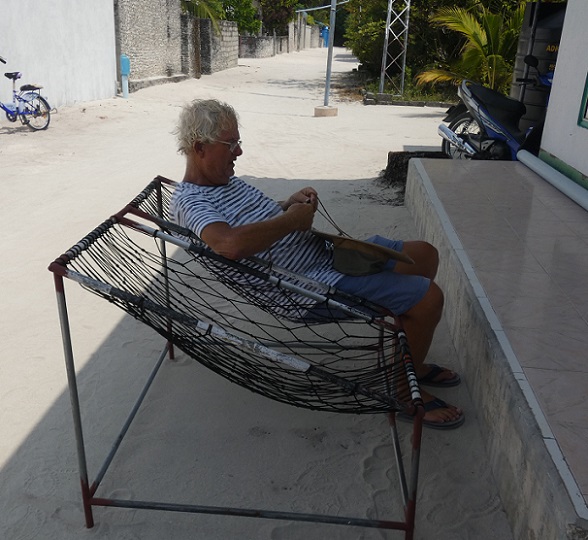
It took us a while to realize that these frames of netting that were all over the village were seats as demonstrated here by Wayne
Now a bit of information about the Maldives. Because I am running out of time before we leave for Djibouti, I am going to cheat and quote directly and selectively (omitting the reference numbers) from Wikipedia:
"The Maldives consists of 1,192 coral islands grouped in a double chain of 26 atolls, that stretch along a length of 871 kilometres (541 miles) north to south, 130 kilometres (81 miles) east to west, spread over roughly 90,000 square kilometres (35,000 sq mi), of which only 298 km2 (115 sq mi) are dry land, making this one of the world's most dispersed countries. It lies between latitudes 1°S and 8°N, and longitudes 72° and 74°E. The atolls are composed of live coral reefs and sand bars, situated atop a submarine ridge 960 kilometres (600 mi) long that rises abruptly from the depths of the Indian Ocean and runs north to south."
The "Maldives is the lowest country in the world, with maximum and average natural ground levels of only 2.4 metres (7 ft 10 in) and 1.5 metres (4 ft 11 in) above sea level, respectively. In areas where construction exists, however, this has been increased to several metres. More than 80 per cent of the country's land is composed of coral islands which rise less than one metre above sea level. As a result, the Maldives are at high risk of being submerged due to rising sea levels." Options of purchasing land to which Maldivians could migrate in India, Sri Lanka, and Australia have been investigated.
"The Maldives were devastated by a tsunami on 26 December 2004, following the Indian Ocean earthquake. Only nine islands were reported to have escaped any flooding, [one of which appears to have been Uligamu] while fifty-seven islands faced serious damage to critical infrastructure, fourteen islands had to be totally evacuated, and six islands were destroyed. A further twenty-one resort islands were forced to close because of tsunami damage. The total damage was estimated at more than US$400 million, or some 62% of the GDP. 102 Maldivians and 6 foreigners reportedly died in the tsunami. The destructive impact of the waves on the low-lying islands was mitigated by the fact there was no continental shelf or land mass upon which the waves could gain height. The tallest waves were reported to be 14 feet (4.3 m) high."
"In 1988, Maldivian authorities claimed that sea rise would 'completely cover this Indian Ocean nation of 1,192 small islands within the next 30 years.' The Intergovernmental Panel on Climate Change's 2007 report predicted the upper limit of the sea level rise will be 59 centimetres (23 in) by 2100, which means that most of the republic's 200 inhabited islands may need to be abandoned. According to researchers from the University of Southampton, the Maldives are the third most endangered island nation due to flooding from climate change as a percentage of population."
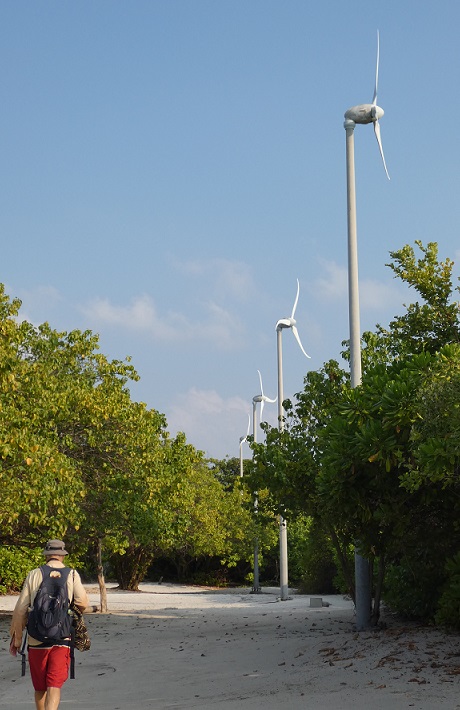
Remains of a wind farm that is largely inoperable now, built in 2007 by a US company but without training local technicians. Solar and wind provide the village's power.
Historically, the Maldives have been inhabited since, at least, 500 BC. "In the 12th century Islam reached the Maldivian Archipelago, which was consolidated as a sultanate, developing strong commercial and cultural ties with Asia and Africa. From the mid-16th century, the region came under the increasing influence of European colonial powers [the usual sequence of Portuguese, Dutch, and British] with the Maldives becoming a British protectorate in 1887. Independence from the United Kingdom came in 1965, and a presidential republic was established in 1968 with an elected People's Majlis. The ensuing decades have seen political instability, efforts at democratic reform..." with the most widespread recent constitutional and electoral reforms in 2008.
The Islands have strategic value because of their location along the maritime "Silk Road" but their own exports were mostly fish, cowrie shells (used in places as currency), and coconut products. Tourism started to be developed in the 1970s and now constitutes the nation's main source of foreign income. "Tourism accounts for 28% of the GDP and more than 60% of the Maldives' foreign exchange receipts. Over 90% of government tax revenue comes from import duties and tourism-related taxes...As of 2008, 89 resorts in the Maldives offered over 17,000 beds and hosted over 600,000 tourists annually. In 2019, over 1.7 million visitors came to the islands." Oddly, Since the Maldives do not have an extradition treaty with the US or many other countries, the capital, Malee is currently (during the Ukraine war) home to a fleet of mega-yachts owned by Russian oligarchs.
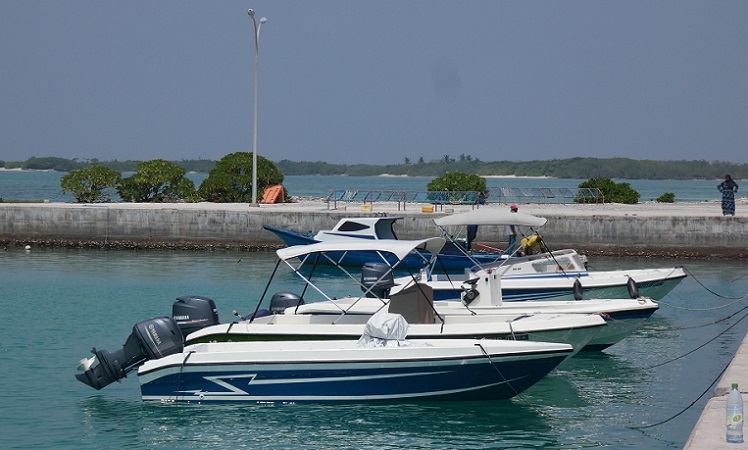
New-looking, local speedboats within Uligamu harbor
All is not perfect in this Island nation. Political unrest continues and "The United States Bureau of Democracy, Human Rights and Labor claims in their 2012 report on human rights practices in the country that the most significant problems are corruption, lack of religious freedom, abuse, and unequal treatment of women." With Islam as the official religion, the open practice any other religion is forbidden. All of the women that we have seen wear head scarves and are covered from neck to wrists and ankles.
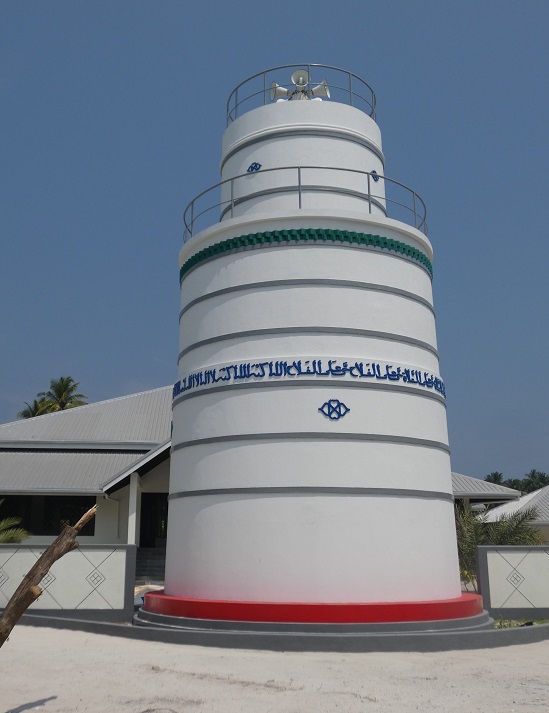
The interesting mosque tower looking a bit like a lighthouse in Uligamu
OK, back to our activities...
We spent most of Friday completing online and boat chores, including washing salt off the Bimini windows and cove-stripe, and getting the dinghy out of the cabin, installing the floor plates, inflating it, and installing the outboard motor. The following day, we ventured ashore to find a very neat harbor surrounded by a fairly new-looking breakwater. The village was also extremely tidy with the sand roads and yards freshly swept.
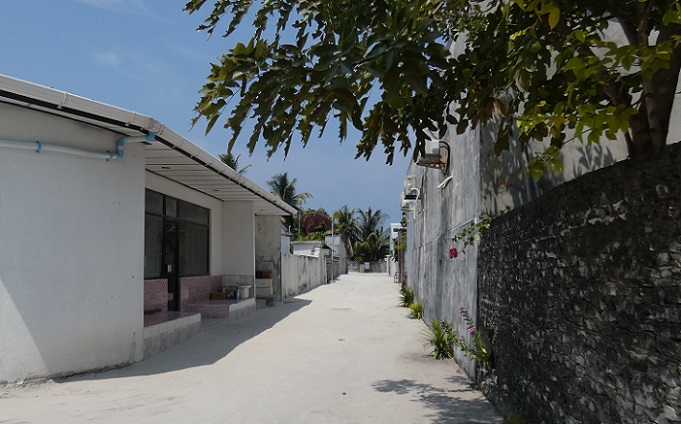
Typical street (mostly moped traffic) in Uligamu
The village was quite prosperous looking with many of the houses built of cement, but others have coral rock walls (or facing). There was hardly a weed in sight. Assad and Hammad arranged for us to get three of our jerry cans (60 L or 15 US gallons) refilled with diesel, and at US$1.50 per L, it was no more expensive than in Sri Lanka.
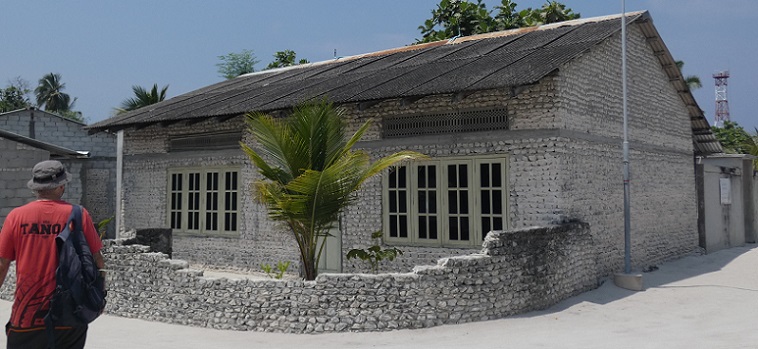
A house with coral stone walls
Late on Friday, Eugenie and Paul arrived from Phuket on Deo Juvante, and the next morning, Jackie and Wayne appeared from further south in the Maldives on CathayOz. With Hans from Ikinoo leading the way, we were given the grand tour of Uligamu, including the two small grocery stores, bakery, and restaurant. After ordering a loaf of multigrain bread and six baguettes (between three boats) to pick up the next day, we retired to the restaurant.
Although English is generally understood by many people in the Maldives, our ordering skills were rather confused until Assad came along and helped translate. We ended up with virgin mojitos and either fried rice or fried noodles (a bit of a throwback to Indonesia). As there is no ATM in Uligamu, Assad also acted as money exchanger, providing Maldivian Rufiyaas, at a rate of about 15 per US dollar. It was fun to have four rally boat crews reunited, and rather reassuring to know that we would all be heading in the same direction eventually.

Rally reunion lunch in Uligamu - L to R: Randall, Paul, Eugenie, Alison, Jackie, Wayne, Sonja, and Hans
If our selections from the restaurant had seemed tasty but a bit tame, we had a more diverse taste of local cuisine on Sunday evening, as arranged by Assad. Many of the local women had prepared various dishes, mostly forms of curry, and all of the boat crews were invited to participate in a delicious buffet dinner. It was a lovely gathering, and we were joined by a few of the immigration and customs officials. It was held with tables and chairs set up on a wide sand spit at the southwest corner of the Island. Apparently, most of this beach moves with the seasons, being eroded from this corner and redeposited off the southeast corner when the monsoon switches from the current dry northeast monsoon to the moist southwest monsoon during April and May.
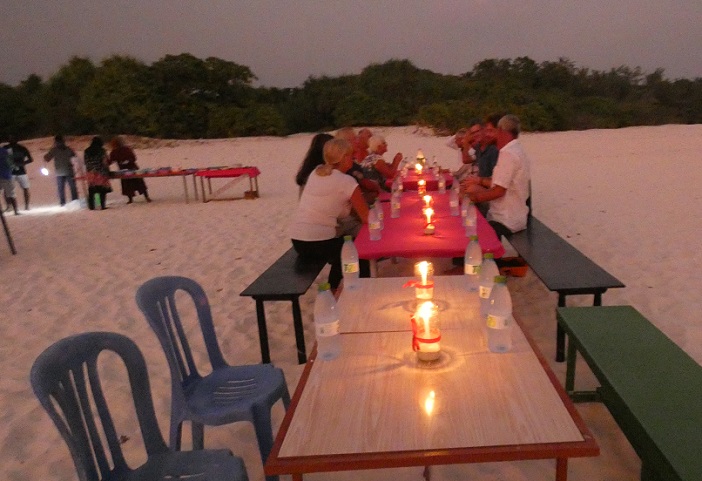
Local meals served as a buffet on the temporary beach at the southwest corner of Uligamu
By Sunday, I was feeling strong enough again to consider snorkeling. You have to know that I had been pretty sick if I had resisted entering such clear water for a couple of days. We had been warned that the coral was in very bad shape and so it was. There were coral clumps regrowing, especially in the deeper water, but there was also much rubble and old coral rock. There had been very high water-temperatures and bad bleaching events in 1998 and 2016, and Assad told us that there had also been infestations of crown-of-thorns starfish, which had contributed to the problems and hindered regrowth of some corals.

Crown-of-thorn starfish (about 20 cm or 9 inches)
What the area lacked in good corals, however, it made up for with a wonderful array of fish, high in both numbers and diversity. Our first snorkel was off the northwest point of the Island where we anchored the dinghy in sand and explored a gradient from depths of about 4 m to 12 m (13 - 40 feet). In the deeper water, the number and diversity of larger fish was impressive. No signs of massive over-fishing here.
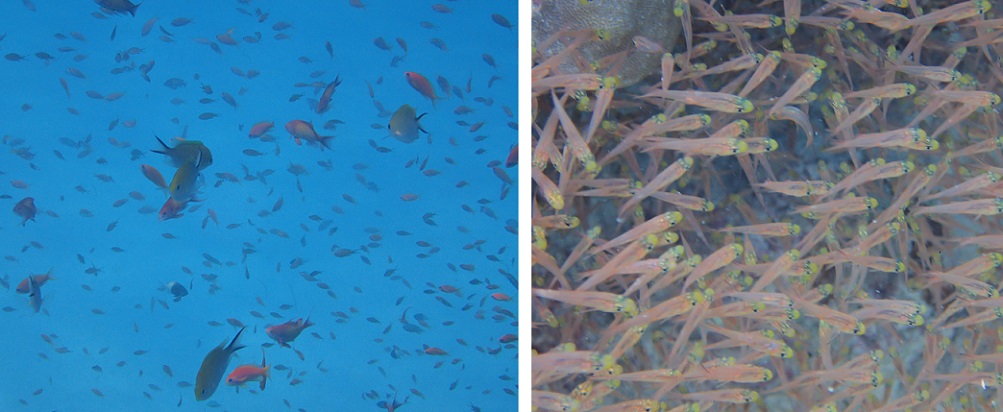
There were many dense groups of small fish either in open water like these anthias and chromis or lurking in the shelter of the coral like these black-nosed cardinalfish (to 6 cm or 2.5 inches).
Confusingly, there are many fish that are new species to us that are an Indian Ocean version of similar species from the Pacific, so I had to be careful not so misidentify them on my REEF surveys. I have yet to go through my species lists thoroughly, but I am sure that we logged at least 12 species that are new to our life-lists.
During our second snorkel on Monday, we drifted northward with Randall towing the dinghy, from the southwest corner of the Island. Staying on the edge of the shoreline reef, we covered a large area and saw a huge number of fish. Interestingly, although there were many circumtropical species, there were also many species missing that we have been seeing in the past. It was evident that we had entered a different ocean with the separate evolution of certain groups of fish. There were far fewer damselfish and wrasse than we have been seeing in the Pacific. Of course, the poor condition of the coral may have influenced this also.
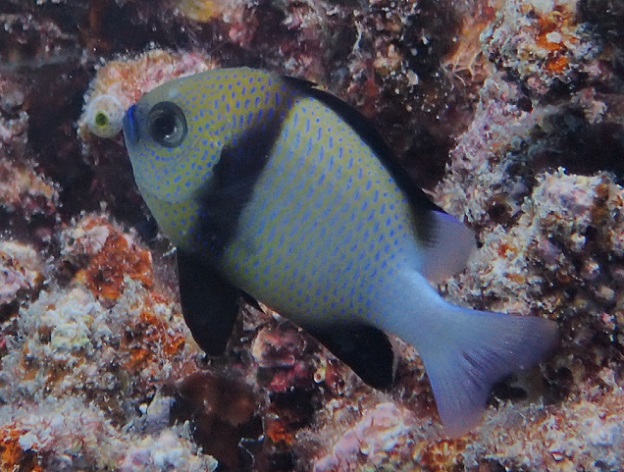
This Indian dascyllus (to 7 cm or 3 inches) was very similar to the reticulated dascyllus we have been seeing for years.

Similarly, this Indian triggerfish (to 24 cm or 10 inches) was almost identical...but not quite...to the black triggerfish. These fish swim by undulating their dorsal and ventral fins, so they are quite interesting to watch open water.
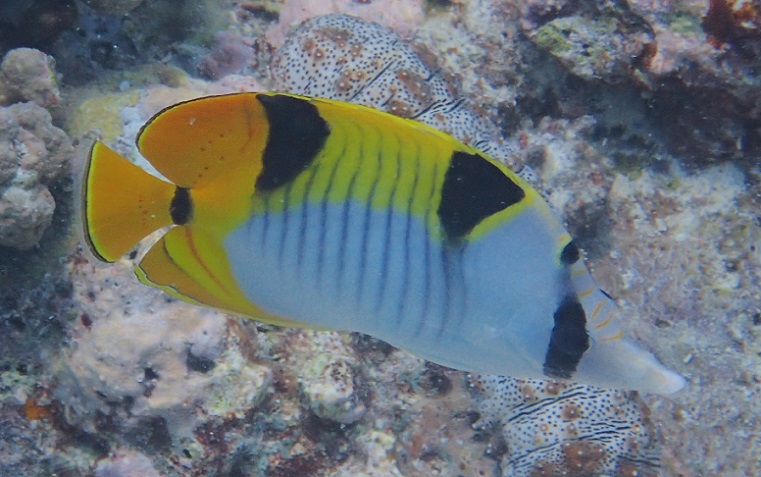
This saddleback butterflyfish (to 20 cm or 9 inches) was deceptively similar to the Pacific double-saddle butterfly fish...

...but this yellowhead butterflyfish (to 20 cm or 9 inches) was a pleasingly original species, quite unlike any butterflyfish that we have seen elsewhere.
The marine life was not only visible while snorkeling. During some late afternoons, we were treated to a display of slowly moving manta rays feeding in the anchorage on either side of Tregoning. I had contemplated getting in the water for a closer look but once I realized that they were actually moving quite fast compared to my rate of snorkeling, I decided to enjoy the view from the surface. Another evening, a pod of maybe 100 small dolphins (I am guessing spinner dolphins) passed through. The marine abundance of the area was amazing. Combined with the fabulously clear water, I positively ached to be snorkeling all the time.
On Tuesday morning, we did a short bird walk that netted a grand total of six species (all seen before), so it was quite a contrast to the diversity in Sri Lanka. Of course, this is not a great surprise for a remote oceanic island. Apparently, there are more interesting species on Maldivian Islands further south.

A juvenile Indian pond heron (to 45 cm or 18 inches)
The rest of the day was spend preparing ourselves and Tregoning for our long passage to Djibouti. The supply vessel had arrived on Monday, so we were able to get a few extra provisions (mostly fresh fruit and vegetables) and, being Valentine's Day, I was treated to a bar of chocolate, and we shared a tub of chocolate ice-cream! A fifth rally boat, SV Incentive with Sanne and Rik aboard, arrived from Sri Lanka on Tuesday afternoon, but we had already packed the dinghy below decks, and they had not launched theirs yet, so we will have to hope to see them again in Djibouti.
The passage to Djibouti is about 2,200 nm, and we will undoubtedly have to motor at times as insufficient wind is more likely than too much. Having just heard about all the damage in New Zealand from a far-south roaming cyclone there, I am not sorry to think that we may be floating waiting for wind rather than fighting too much of it...but we shall have to see. We will be in daily contact with two security agencies as we make the passage, one as soon as we leave Uligamu, and the other during our passage through the section of shipping channel at the mouth of the Red Sea. It promises to be an interesting voyage...I am certainly hoping that both halves go smoothly, and we will be in touch again soon from Djibouti.
We had left Sri Lanka at exactly the time we predicted, 8 am on Sunday (5th February). Our agent Uresh had come to the boat at 7:30 am and we followed him to the Immigration Office to get the exit stamps in our passports. He then kindly waited to help with our docklines, although several neighboring sailors, including Klara, were keen to assist. There was no wind, so it was easy to have the lines released from the dock, our bow was given a good shove, and we could simply clear the boat in front of us and maneuver out of the small yacht basin. The process was made easier by Randall and me having removed all the rubber snubbers from the docklines and reversed them, so that they could be untied from the dock rather than the boat.
Our four fenders had made a valiant effort in the trying circumstances of the surge and assorted rubber buffers on the concrete wall. Our only ball-float had started to deflate in the final couple of days, but we think that Randall may be able to patch it with dinghy repair equipment. Three of the fender covers were completely destroyed, and one I was able to salvage, although it now looks as though it had been a test dummy for make-up artists for a Frankenstein movie...the artists who were rejected... The covers are not intended to protect the fenders but to prevent them from grinding dirt into the hull's paint. I have one unused cover left but I suppose that I will have to get more fabric and start again for the rest...sigh.
Leaving Galle, we motored for about eight hours into the Laccadive Sea (which divides Sri Lanka and India), until the wind filled in. The angle was good, so we just unfurled the jib and for the next 38 hours, that was all that we needed. The waves seemed unnecessarily sloppy and choppy during the night and Monday morning, but after that they gradually eased, and conditions became very pleasant. With the wind decreasing and coming more from off the bow rather than the stern, we raised the mainsail around dawn on Tuesday, and it looked as though it was going to be a very uneventful, enjoyable passage.
Those of delicate constitution are encouraged to skip the next two paragraphs.
Within a couple of hours, however, the bottom fell out of my world...or the other way around, and the happy half of the passage was over. After some hurried trips to the head (boat's toilet), I found myself on watch at 8 am, starting to shiver, despite warm weather, sweatpants, and my raincoat. Quickly administering the medical thermometer, Randall confirmed that I was getting a fever at 100.4°F (38 °C), so off I was sent to bed. Uh oh... next I was purging in both directions despite not having much left in my system. Having being fortunate enough to have a stomach that I have often rather brashly described as like a concrete mixer, and being so lucky never to have been actually seasick, I was a bit of a novice at heaving over the side. By that stage it was more of a reflex gesture than actually accomplishing anything.
Four hours of sleep later, Randall was horrified to find that my temperature had increased to 103.5°F (39.7°C). It was time to implement some of the suggestions in the various "Medicine Aboard" types of books that he had been reading while I slept. I was able to keep small amounts of electrolyte solution/Gatorade down by this time, so he started me on a three-day course of Cipro antibiotic. Even though they were simply swallowed, they are some of the bitterest things I have ever tasted...yuk! Thankful that the vomiting was over, I was not quite as confident about the other problem, so I constructed a homemade diaper from an old handtowel sandwiched between two pairs of knickers. It probably looked as pathetic as it sounds.
Thankfully, by 4 pm my temperature was starting to recede, but Randall nobly planned how he would accomplish all of the night watches on his own, allowing me to sleep. He made himself a bed in the cockpit and set his alarm to wake him every 15 or 20 minutes to look around. It was obviously not a very restful night for him, and he has a greater sympathy for single handers now, but it made all the difference to me. By 8 am, my temperature was close to normal, and I was feeling well enough to sit up in the cockpit and read while on watch, letting Randall get several hours of much-needed sleep.
Just before midnight, Randall had furled the jib and started the engine because the wind was too light. We motor-sailed with the mainsail and very low rpms on the engine the rest of the way, about another 34 hours. We could have arrived at Uligamu several hours earlier than 10 am on Thursday, but we wanted to be sure to have good light as we entered the atoll and looked for somewhere to anchor. I was not sorry to have as much time as possible to continue to recover my strength.
Which particular type of gastric infection had I suffered, we could not tell but the Cipro and a good dose of Pepto-Bismol seemed to settle things down. Of course, I started to suspect every food that I had eaten in the preceding 72 hours. Several, probably innocent, items took a trip to the depths to be sure...not much seemed appetizing for a while so this was no great hardship for me. In all of our traveling, Randall and I have been remarkably lucky in hardly ever having Delhi Belly or some version thereof. We do not drink water ashore, and wash fruit etc., before eating it. I probably have an injudiciously cavalier attitude towards salads, but the only things that we had eaten ashore within 24 hours before we left were some bakery items that we shared. Two places that we ate onshore slightly surprised us by bringing the requested cutlery dipped in a bowl of water (of unknown origin), but those meals had been long before our departure. So, we shall never know the source of this ailment, a puzzle particularly confused by the fact that Randall and I had eaten and drunk the same things for the last few days and he, mercifully, never succumbed.
One of the things that I tend to do in times of anxiety or stress is repeatedly hum/sing the same tune. I try to keep it to myself as I know how annoying this can be and, as I have mentioned before, the song tends to become forever associated for me with the threatening event or conditions. During the latter half of the previous passage with the savagely flogging partial-jib, I had found myself stuck in a rut with the Beatles song "Run For Your Life" which has a driving, memorable rhythm and melody. However, I was not happy about the aggressively misogynistic words pumping around in my head such as the leading line of "I'd rather see you dead, little girl, than to be with another man." Especially in these PC times, they seem totally inappropriate. I was annoyed at this lingering sentiment, but it was a hard song to shake.
Once in Galle, we watched a video of a (Dixie) Chicks concert and I was happy to swap my Beatles brain-worm for "Goodbye, Earl", a song about a badly abused wife murdering her husband undetected. Prior to our next passage, I shall hope to cultivate a song that is a little less controversial, but it is completely unpredictable which song I will find myself repeating over and over when anxious.
Our clearance into Uligamu was the antithesis of anxious. After arriving at 10 am, we sorted out the cockpit and went through our "Arrival" checklist. We had been assured by our agent, Assad, that he would see our arrival (we had sent him a message with a fairly accurate estimate of arrival time), and we would be visited by the officials once we were anchored. By noon, with no sign of a visit, we decided to have lunch and then contact Assad by Iridium email.
He soon replied that the Customs Officer was detained with another vessel, and they would come to us at 3:30 pm. It was closer to 4:30 pm when a very smart launch appeared with six people aboard, including the boat captain. We tied it alongside and they all came aboard to fill the cockpit. Assad introduced himself and his associate, Hammad, and then handed over the delightful gift of 1.5L of Neapolitan ice cream...yum! As I said before, I am not sure if this is typical (and I hesitate to ask others in case it is not) or because we had waited so long. Either way, he had instantly won our approval.
Randall had sent him many documents by email and, for once, there was no need for us to produce these again. The security officer, in army uniform, had one form for us to fill out with the usual information, but everything else Assad had already completed, and all Randall had to do was sign and stamp. Again, it seems that the smaller the country, the happier they are with a boat stamp and a pile of papers. I was too tired to catch the names of the other officers, but the Health Officer signed and gave us the Certificate of Pratique. She also told us that we could take down our quarantine flag and we were permitted to go ashore.
We had been told that any alcohol on board would be confiscated by Customs, to be returned on our departure. The Maldives is a Muslim country and neither alcohol nor pork can be brought ashore. In fact, we checked the "yes" box on the Customs form to say that we did have some alcohol aboard (half a bottle of red wine and half a bottle of Sri Lankan rum) but it was never mentioned again. We were, however, given a half page of "Some useful information and advice (Port of Uligan)" which listed what we can and cannot do. This included dressing appropriately ashore (covering shoulders to the knee), and not taking any alcohol off the vessel. While this might seem a bit officious, we were very impressed and pleased that they had made clear all of the things that had been ambiguous or unclear in other Muslim places we had visited.

The most surreal part of the visit was while Randall and Assad were dealing with the pile of paperwork, the Customs Officer, on learning that we had done research at a university was keen to tell us about his idea for a research paper that he was working on. If he ever explained what this project was for, or when, I missed it, but the topic he wanted to review was the disadvantages of democracy. At first, I wondered if this was a test for us Americans to see if we would argue that democracy was the only way to go and had no downsides. But it appeared that it was a topic that he really did want to examine with reference to the relatively short duration of democracy in the Maldives, only since 2008. He did not seem to think that it was going well or was appropriate in all types of nations and he wanted to compare experiences with democracy in many other countries, with a special focus on island nations. It actually sounded like a very interesting but expansive and deeply complex topic into which he would need to focus a narrow theme. Given the current political schisms and incivility in the US, it certainly would be interesting to take a deep look at the downsides of democracy although I am certain that there are many books on this topic.
Regardless of what he might accomplish in researching this topic, it was an unexpected and interesting discussion to be having with a Customs Officer as we applied to enter his country. He soon dropped the topic as the paperwork was complete and the group relaxed to tell us proudly all about their island (population 550), while happily drinking pineapple juice and eating cookies and apricots that we had provided as refreshments.
They eventually departed with our passports and a promise to return them with our Clearance Certificate the following day. Phew! We had not expected to host a party, but it had been great fun and quite educational, although being pretty tired, I doubted that I would remember much. We had been told the best places to go snorkeling, that there was a ferry service between islands that we could take, and that one evening Assad would organize a pot-luck dinner with the locals, or something similar. He was expecting four more boats to arrive the next day, and 10 more during the week so it was going to get busier and busier in the anchorage.

It took us a while to realize that these frames of netting that were all over the village were seats as demonstrated here by Wayne
Now a bit of information about the Maldives. Because I am running out of time before we leave for Djibouti, I am going to cheat and quote directly and selectively (omitting the reference numbers) from Wikipedia:
"The Maldives consists of 1,192 coral islands grouped in a double chain of 26 atolls, that stretch along a length of 871 kilometres (541 miles) north to south, 130 kilometres (81 miles) east to west, spread over roughly 90,000 square kilometres (35,000 sq mi), of which only 298 km2 (115 sq mi) are dry land, making this one of the world's most dispersed countries. It lies between latitudes 1°S and 8°N, and longitudes 72° and 74°E. The atolls are composed of live coral reefs and sand bars, situated atop a submarine ridge 960 kilometres (600 mi) long that rises abruptly from the depths of the Indian Ocean and runs north to south."
The "Maldives is the lowest country in the world, with maximum and average natural ground levels of only 2.4 metres (7 ft 10 in) and 1.5 metres (4 ft 11 in) above sea level, respectively. In areas where construction exists, however, this has been increased to several metres. More than 80 per cent of the country's land is composed of coral islands which rise less than one metre above sea level. As a result, the Maldives are at high risk of being submerged due to rising sea levels." Options of purchasing land to which Maldivians could migrate in India, Sri Lanka, and Australia have been investigated.
"The Maldives were devastated by a tsunami on 26 December 2004, following the Indian Ocean earthquake. Only nine islands were reported to have escaped any flooding, [one of which appears to have been Uligamu] while fifty-seven islands faced serious damage to critical infrastructure, fourteen islands had to be totally evacuated, and six islands were destroyed. A further twenty-one resort islands were forced to close because of tsunami damage. The total damage was estimated at more than US$400 million, or some 62% of the GDP. 102 Maldivians and 6 foreigners reportedly died in the tsunami. The destructive impact of the waves on the low-lying islands was mitigated by the fact there was no continental shelf or land mass upon which the waves could gain height. The tallest waves were reported to be 14 feet (4.3 m) high."
"In 1988, Maldivian authorities claimed that sea rise would 'completely cover this Indian Ocean nation of 1,192 small islands within the next 30 years.' The Intergovernmental Panel on Climate Change's 2007 report predicted the upper limit of the sea level rise will be 59 centimetres (23 in) by 2100, which means that most of the republic's 200 inhabited islands may need to be abandoned. According to researchers from the University of Southampton, the Maldives are the third most endangered island nation due to flooding from climate change as a percentage of population."

Remains of a wind farm that is largely inoperable now, built in 2007 by a US company but without training local technicians. Solar and wind provide the village's power.
Historically, the Maldives have been inhabited since, at least, 500 BC. "In the 12th century Islam reached the Maldivian Archipelago, which was consolidated as a sultanate, developing strong commercial and cultural ties with Asia and Africa. From the mid-16th century, the region came under the increasing influence of European colonial powers [the usual sequence of Portuguese, Dutch, and British] with the Maldives becoming a British protectorate in 1887. Independence from the United Kingdom came in 1965, and a presidential republic was established in 1968 with an elected People's Majlis. The ensuing decades have seen political instability, efforts at democratic reform..." with the most widespread recent constitutional and electoral reforms in 2008.
The Islands have strategic value because of their location along the maritime "Silk Road" but their own exports were mostly fish, cowrie shells (used in places as currency), and coconut products. Tourism started to be developed in the 1970s and now constitutes the nation's main source of foreign income. "Tourism accounts for 28% of the GDP and more than 60% of the Maldives' foreign exchange receipts. Over 90% of government tax revenue comes from import duties and tourism-related taxes...As of 2008, 89 resorts in the Maldives offered over 17,000 beds and hosted over 600,000 tourists annually. In 2019, over 1.7 million visitors came to the islands." Oddly, Since the Maldives do not have an extradition treaty with the US or many other countries, the capital, Malee is currently (during the Ukraine war) home to a fleet of mega-yachts owned by Russian oligarchs.

New-looking, local speedboats within Uligamu harbor
All is not perfect in this Island nation. Political unrest continues and "The United States Bureau of Democracy, Human Rights and Labor claims in their 2012 report on human rights practices in the country that the most significant problems are corruption, lack of religious freedom, abuse, and unequal treatment of women." With Islam as the official religion, the open practice any other religion is forbidden. All of the women that we have seen wear head scarves and are covered from neck to wrists and ankles.

The interesting mosque tower looking a bit like a lighthouse in Uligamu
OK, back to our activities...
We spent most of Friday completing online and boat chores, including washing salt off the Bimini windows and cove-stripe, and getting the dinghy out of the cabin, installing the floor plates, inflating it, and installing the outboard motor. The following day, we ventured ashore to find a very neat harbor surrounded by a fairly new-looking breakwater. The village was also extremely tidy with the sand roads and yards freshly swept.

Typical street (mostly moped traffic) in Uligamu
The village was quite prosperous looking with many of the houses built of cement, but others have coral rock walls (or facing). There was hardly a weed in sight. Assad and Hammad arranged for us to get three of our jerry cans (60 L or 15 US gallons) refilled with diesel, and at US$1.50 per L, it was no more expensive than in Sri Lanka.

A house with coral stone walls
Late on Friday, Eugenie and Paul arrived from Phuket on Deo Juvante, and the next morning, Jackie and Wayne appeared from further south in the Maldives on CathayOz. With Hans from Ikinoo leading the way, we were given the grand tour of Uligamu, including the two small grocery stores, bakery, and restaurant. After ordering a loaf of multigrain bread and six baguettes (between three boats) to pick up the next day, we retired to the restaurant.
Although English is generally understood by many people in the Maldives, our ordering skills were rather confused until Assad came along and helped translate. We ended up with virgin mojitos and either fried rice or fried noodles (a bit of a throwback to Indonesia). As there is no ATM in Uligamu, Assad also acted as money exchanger, providing Maldivian Rufiyaas, at a rate of about 15 per US dollar. It was fun to have four rally boat crews reunited, and rather reassuring to know that we would all be heading in the same direction eventually.

Rally reunion lunch in Uligamu - L to R: Randall, Paul, Eugenie, Alison, Jackie, Wayne, Sonja, and Hans
If our selections from the restaurant had seemed tasty but a bit tame, we had a more diverse taste of local cuisine on Sunday evening, as arranged by Assad. Many of the local women had prepared various dishes, mostly forms of curry, and all of the boat crews were invited to participate in a delicious buffet dinner. It was a lovely gathering, and we were joined by a few of the immigration and customs officials. It was held with tables and chairs set up on a wide sand spit at the southwest corner of the Island. Apparently, most of this beach moves with the seasons, being eroded from this corner and redeposited off the southeast corner when the monsoon switches from the current dry northeast monsoon to the moist southwest monsoon during April and May.

Local meals served as a buffet on the temporary beach at the southwest corner of Uligamu
By Sunday, I was feeling strong enough again to consider snorkeling. You have to know that I had been pretty sick if I had resisted entering such clear water for a couple of days. We had been warned that the coral was in very bad shape and so it was. There were coral clumps regrowing, especially in the deeper water, but there was also much rubble and old coral rock. There had been very high water-temperatures and bad bleaching events in 1998 and 2016, and Assad told us that there had also been infestations of crown-of-thorns starfish, which had contributed to the problems and hindered regrowth of some corals.

Crown-of-thorn starfish (about 20 cm or 9 inches)
What the area lacked in good corals, however, it made up for with a wonderful array of fish, high in both numbers and diversity. Our first snorkel was off the northwest point of the Island where we anchored the dinghy in sand and explored a gradient from depths of about 4 m to 12 m (13 - 40 feet). In the deeper water, the number and diversity of larger fish was impressive. No signs of massive over-fishing here.

There were many dense groups of small fish either in open water like these anthias and chromis or lurking in the shelter of the coral like these black-nosed cardinalfish (to 6 cm or 2.5 inches).
Confusingly, there are many fish that are new species to us that are an Indian Ocean version of similar species from the Pacific, so I had to be careful not so misidentify them on my REEF surveys. I have yet to go through my species lists thoroughly, but I am sure that we logged at least 12 species that are new to our life-lists.
During our second snorkel on Monday, we drifted northward with Randall towing the dinghy, from the southwest corner of the Island. Staying on the edge of the shoreline reef, we covered a large area and saw a huge number of fish. Interestingly, although there were many circumtropical species, there were also many species missing that we have been seeing in the past. It was evident that we had entered a different ocean with the separate evolution of certain groups of fish. There were far fewer damselfish and wrasse than we have been seeing in the Pacific. Of course, the poor condition of the coral may have influenced this also.

This Indian dascyllus (to 7 cm or 3 inches) was very similar to the reticulated dascyllus we have been seeing for years.

Similarly, this Indian triggerfish (to 24 cm or 10 inches) was almost identical...but not quite...to the black triggerfish. These fish swim by undulating their dorsal and ventral fins, so they are quite interesting to watch open water.

This saddleback butterflyfish (to 20 cm or 9 inches) was deceptively similar to the Pacific double-saddle butterfly fish...

...but this yellowhead butterflyfish (to 20 cm or 9 inches) was a pleasingly original species, quite unlike any butterflyfish that we have seen elsewhere.
The marine life was not only visible while snorkeling. During some late afternoons, we were treated to a display of slowly moving manta rays feeding in the anchorage on either side of Tregoning. I had contemplated getting in the water for a closer look but once I realized that they were actually moving quite fast compared to my rate of snorkeling, I decided to enjoy the view from the surface. Another evening, a pod of maybe 100 small dolphins (I am guessing spinner dolphins) passed through. The marine abundance of the area was amazing. Combined with the fabulously clear water, I positively ached to be snorkeling all the time.
On Tuesday morning, we did a short bird walk that netted a grand total of six species (all seen before), so it was quite a contrast to the diversity in Sri Lanka. Of course, this is not a great surprise for a remote oceanic island. Apparently, there are more interesting species on Maldivian Islands further south.

A juvenile Indian pond heron (to 45 cm or 18 inches)
The rest of the day was spend preparing ourselves and Tregoning for our long passage to Djibouti. The supply vessel had arrived on Monday, so we were able to get a few extra provisions (mostly fresh fruit and vegetables) and, being Valentine's Day, I was treated to a bar of chocolate, and we shared a tub of chocolate ice-cream! A fifth rally boat, SV Incentive with Sanne and Rik aboard, arrived from Sri Lanka on Tuesday afternoon, but we had already packed the dinghy below decks, and they had not launched theirs yet, so we will have to hope to see them again in Djibouti.
The passage to Djibouti is about 2,200 nm, and we will undoubtedly have to motor at times as insufficient wind is more likely than too much. Having just heard about all the damage in New Zealand from a far-south roaming cyclone there, I am not sorry to think that we may be floating waiting for wind rather than fighting too much of it...but we shall have to see. We will be in daily contact with two security agencies as we make the passage, one as soon as we leave Uligamu, and the other during our passage through the section of shipping channel at the mouth of the Red Sea. It promises to be an interesting voyage...I am certainly hoping that both halves go smoothly, and we will be in touch again soon from Djibouti.
Comments
| Vessel Name: | Tregoning |
| Vessel Make/Model: | Morgan Classic 41 |
| Hailing Port: | Gainesville, FL |
| Crew: | Alison and Randall |
| About: | We cast-off from Fernandina Beach in north Florida on 1st June 2008 and we have been cruising on Tregoning ever since. Before buying Tregoning, both of us had been sailing on smaller boats for many years and had worked around boats and water throughout our careers. |
| Extra: | “Tregoning” (rhymes with “belonging”) and is a Cornish word (meaning “homestead of Cohnan” or “farm by the ash trees”) and was Alison's mother’s middle name. Cornwall is in southwest England and is where Alison grew-up. |
Tregoning's Photos - Main
 |
Extra photographs from our three-week campervan tour of the South Island from November 15th to December 5th 2015
217 Photos
Created 4 January 2016
|
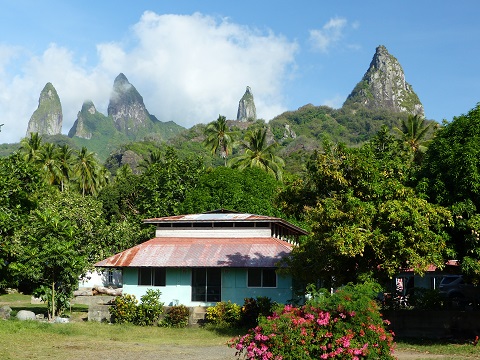 |
Random pictures from our month spent on the islands of Hiva Oa, Tahuata, Ua Pou, and Nuku Hiva
45 Photos
Created 18 July 2015
|
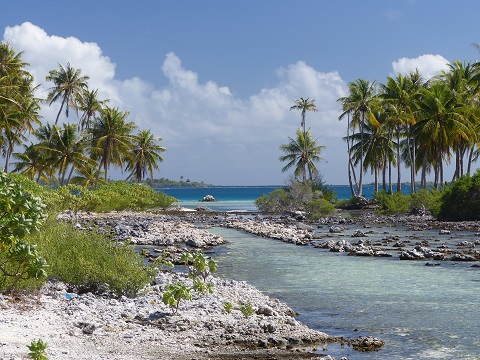 |
Random pictures from our month spent in 4 Tuamotu Atolls; Ahe, Fakarava, Tahanea, and Toau
32 Photos
Created 1 July 2015
|
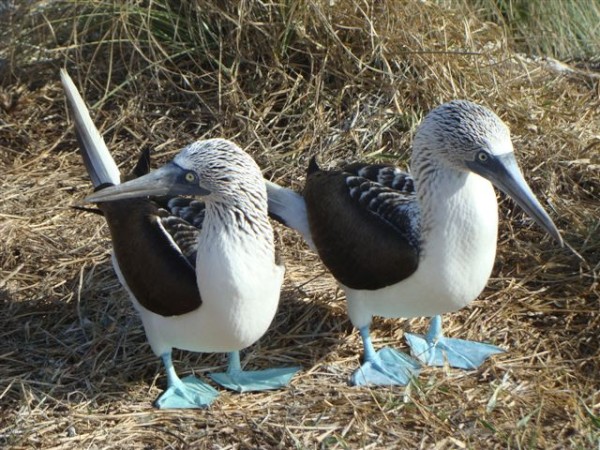 |
Some of the birds, fish, reptiles, and mammals (and others) that we have seen in Mexico
74 Photos
Created 5 May 2014
|
Tregoning

Who: Alison and Randall
Port: Gainesville, FL





